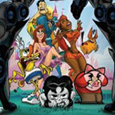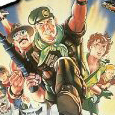Filmation (1987), BCI (May 6, 2008), 1 disc, 91 mins, 1.33:1 original full frame ratio, Dolby Digital Stereo, Rated PG, Retail: $9.98
Storyboard:
The final Filmation show got its start with this little-seen feature. Far out in space on New Texas, a single marshal protects a frontier people from the evil machinations of Stampede and his lackey, Tex Hex.
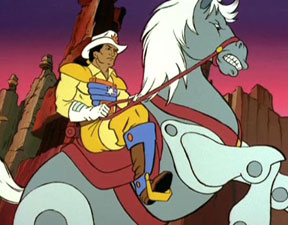
(Note: Much of this review has been re-purposed from our review of The Best Of Bravestarr, which contained this movie.)
The Sweatbox Review:
I have a strange tale to tell. I am not referring to the genre-blending concept behind Bravestarr, but rather the story of the demise of a major animation studio. It is a shame to have to discuss it here, as Bravestarr is considered by Filmation producer Lou Scheimer himself to be Filmation’s crowning achievement. Nevertheless, the film and especially the subsequent series did much to bring about the end of the studio. Filmation had had its first hit with its initial series The New Adventures Of Superman, and through the 1960s and 1970s saw further success with The Archie Show, Fat Albert, Tarzan And The Super 7, and many others. As declining ratings for its shows led to the dwindling of network support for Filmation, they saw their greatest success come in syndication with 1983’s He-Man And The Masters Of The Universe. She-Ra was also popular, and these toy-based hits led to Filmation deciding to develop its own toy line idea to present to Mattel.
Mattel seemingly was sold on the idea, though they did quibble on things like the color of Bravestarr’s costume or the extent of Native American culture to be portrayed. A toy line was produced, but it came to stores several months before the public had gotten its first glimpse of the cartoon. The toy line flopped before it had a chance to be properly promoted, and the series fared little better. To make matters worse, the project had been envisioned to launch with a theatrical film, Bravestarr: The Legend, but a financial backer backed out and the film saw only an extremely limited release, going largely unseen until its initial DVD release in 2007. In short, the whole Bravestarr launch was a total disaster. But that doesn’t mean that the film itself was.
The origin of Bravestarr can actually be traced back to about 1984 during the development of the Ghostbusters show that Filmation did. Lou Scheimer liked something about a character named Tex Hex, who was designed as a lackey for Ghostbusters baddie Prime Evil. Ol’ Tex was put on the backburner for the time being, until another show could be developed that would do him better justice. That show turned out to be Bravestarr, a series that also fulfilled Scheimer’s desire to spotlight a Native American hero, and mixing western themes with science fiction. The result is a somewhat odd blend, with Bravestarr himself sporting a “super cowboy” outfit complete with Indian-themed cowboy hat, and damsels in distress who wear long dresses and bonnets while being attacked by robots. Like other Filmation shows of the past, this one was to present morals at the end of the story, clarifying for younger viewers what we had learned in each story.
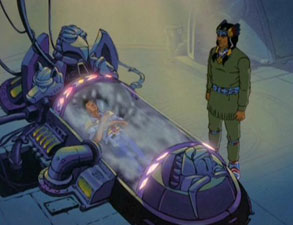
While the “Best Of Bravestarr” DVD included the pilot movie Bravestarr: The Legend on the first disc, and five specially selected episodes from the series run on the second disc, this newer DVD has only the film itself, which includes the origin of our hero. The movie was never edited into episodes for the series, so this is the only place where we can see the introduction of Bravestarr at a young age, lying in a stasis chamber aboard a spaceship about to crash on New Texas. A Native American man stands beside the chamber, speaking of the boy’s destiny. They have evidently escaped some sort of attack, but their foe is still with them. In a nod to Superman, the boy’s escape is made, the intent being to send him where the law-enforcing Galactic Marshals will find him. The larger ship crashes on the planet, but the man survives and shouts in defiance to the evil force that caused the crash, a being known as Stampede. Also on the planet now, Stampede seeks an agent to do his evil bidding and finds a cruel man named Tex, who has just cheated his partner McBride and left him badly injured. Stampede transforms Tex into Tex Hex, now with a skeletal countenance and magical powers. Meanwhile, McBride is rescued, and as he is taken away by medical personnel, we see a crystal drop from his hand. That crystal is Kerium, a miraculous source of power and healing; and as the planet’s hidden wealth becomes known, all the galaxy seems to come to New Texas, in the biggest rush since gold was discovered in the western parts of North America. New Texas becomes the home for countless prospectors and merchants, not to mention thieves. Tex Hex recruits several less-desirable citizens, such as the diminutive robot Cactushead and the serpentine Vipra.

Tex’s gang runs roughshod over the towns of New Texas, and in one town a call for help is made to the galactic Marshals, requesting a thousand men to come and offer assistance in dealing with the threat. Instead, exactly one man is sent, along with a female Judge named J.B. Naturally, that solitary man is Marshall Bravestarr, while the judge is none other than the daughter of McBride, Tex’s former partner. The town is unimpressed by the small delegation, but the Marshall shows surprising strength in dealing with Tex Hex in their first encounter, even if not all goes smoothly. Bravestarr ends up finding Shaman, his old mentor, out in the desert, and learns more of the history of his people. They were apparently a band of Native Americans who had immigrated to another world, only to be sent fleeing when Stampede appeared. Bravestarr learns that Stampede is now on New Texas, and Shaman sends Bravestarr out to find a great weapon to help him fight Stampede. At this point, Bravestarr is fully powered with the strength of a bear, the eyes of a hawk, ears of a wolf, and speed of a puma, all represented by a talisman he wears around his neck.

While Bravestarr does find a formidable gun, he also meets Thirty-Thirty, a horse-robot-man with an attitude. Thirty-Thirty ends up being Bravestarr’s close friend and ally, joining him to fight off Tex Hex’s next attack on the town. This makes the townspeople much more impressed with their new (now super-powered) lawman, even though Bravestarr knows that Tex Hex will be back. Indeed, Tex plans a much larger attack with his legion of evil, and Bravestarr will need everyone in the town to pull together in order to fend them off. This includes both humans and Prairie People, smaller creatures that remind one of western Ewoks, who have to overcome the prejudice of the humans in order to assist them.
Watching the movie now, it is obvious that Filmation had high hopes for the show that was to follow. When a movie starts withSuperman: The Movie-style swooping credits, you know that the creators were aiming high. The film that follows these credits is stuffed with special effects shots that, in those days before computer-assisted post-production, often took seven or eight passes beneath the camera. Never had a Filmation show looked this good. The animation might best be described as economical. I hesitate to use the word “limited”, because at times it looks really quite good. The director knew how to make the most of his budget, keeping quieter character or expository scenes simpler, and saving the best animation for when the action ramped up. The result shows true skill in stretching the budget while making the movie look as epically impressive as possible. It doesn’t all come out perfectly, mind you— the editing is a bit choppy at times, and characters occasionally go off-model. The inclusion of the Prairie People adds some poignancy while dealing with issues of prejudice, but giving them high-pitched voices (notably Bravestarr’s deputy Fuzz) and some silly mannerisms turns them into sometimes unwelcome comic relief.
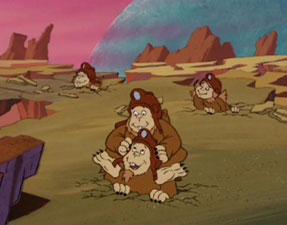
The movie was done by the Filmation television crew, as opposed to other Filmation theatrical films that had their own separate unit working on them (generally this applied to all their other features but this one and Flash Gordon). The drawings are pleasingly realistic and attractive. The characters each have distinct personalities with enough elasticity to offer up interesting personal exchanges and tell stories of emotional depth. The romance between Bravestarr and J.B. has a freshness to it that, although it was downplayed in the series, comes off nicely in the movie. I have to say, however, that Thirty-Thirty is one of the oddest animated characters I’ve ever seen. The idea of a robot that looks like a horse and walks on two legs is different enough, but seeing his supposed partner Bravestarr ride him as he runs on four legs is just weird. It’s just one aspect of a show that has many eccentricities, including the merging of Native American mysticism and iconography with sci-fi concepts. It almost seems a little too “high concept,” but it is certainly interesting to take in. And, as Filmation’s greatest artistic triumph, it’s great to have it preserved on DVD.
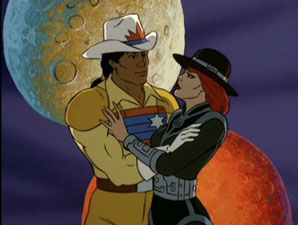
>
Is This Thing Loaded?
This disc carries over just one extra from the impressive “Best Of” set. Andy Mangels hosts an Audio Commentary on the movie with producer Lou Scheimer, director Tom Tataranowicz (mistakenly called Tom Sito on the packaging and in the press material), animator Tom Sito, voice actor Pat Fraley, and voice director Erika Scheimer. This is a very enjoyable and genial commentary, nicely advanced by Mangels, with each participant having surprisingly strong recollections of all aspects of the film’s production. They are all obviously proud of their effort, though they also touch on the disappointing fate of the film, which never had its large-scale release. Included in the discussion is the use of rotoscoping and creation of stock footage for the series that followed, as well as the early use of computer-modelled wireframes that was essentially rotoscoped for animation in the film whenever you see ships or vehicles riding by.
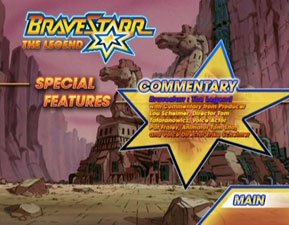
Case Study:
Standard keepcase, no insert. The cover has the image from the movie poster, which is a little busy but still quite appealing. For some reason, this disc release refers to the film as Bravestarr: The Movie on the packaging, though everywhere on the disc it is referred to by its proper name, Bravestarr: The Legend.
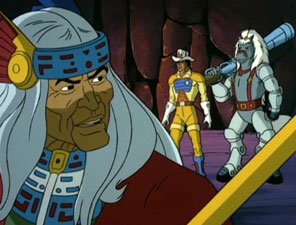
Ink And Paint:
Due to Filmation’s shows never being shipped overseas for animation, their shows have generally always looked unusually clean for the time period in which they were made. With no shipments to Asia, the cels remained remarkably free of the dust normally seen on shows of that era. A hint of shimmer during pans is the only complaint I can make with the video presentation on this disc, as otherwise the image is free of distracting artefacts.

Scratch Tracks:
The 2-channel stereo sound (available in English or Spanish) is probably the best I have ever heard on a Filmation program. The theatrical budget for the film certainly helped as lot, and with the sound design using every opportunity to impress with “swooshes”, explosions, and gunfire. There are no subtitles on this disc.

Final Cut:
For the full collector package, you need to track down the reasonably priced “Best Of” set, which had a fuller complement of extras as well as a few of the best episodes from the subsequent TV series. However, if you missed that set and just wish to see the film that not only sunk the studio but also gave it its most shining artistic moment, this movie-only disc is an even more affordable alternative.
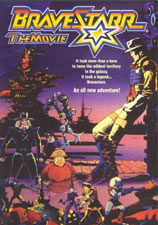 | ||
 |









